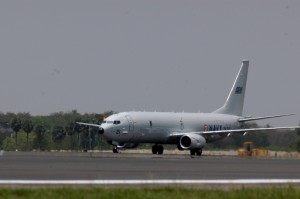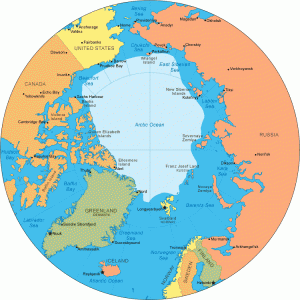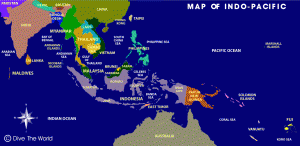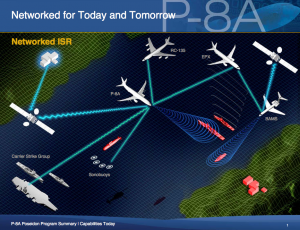2013-10-15 By Robbin Laird and Ed Timperlake
The USN is introducing new platforms and systems in the decade ahead.
These platforms and systems will introduce change in the concepts of operations and re-shape the role which legacy platforms and systems can play in the future. At the heart of the change is expanding the role, which the seabase can play for the joint and coalition forces.
And allies are not standing still. Core allies are adding new platforms and systems at sea and will be important contributors to rethinking the role of maritime assets in providing for global defense and security.
As the USN builds out its capabilities over the next decade, several new systems will either be introduced or come to fruition and these systems will animate change. They will certainly be used to re-shape the concepts of operations of legacy systems and lay down the pattern of change for the decade after next.
A key consideration is how the new platforms and systems coming online in the decade ahead might be used to reshape the overall capability of the fleet and its operations. It is not a question of simply waiting until recapitalization has occurred to shape change; it is building change out from the initial introduction of new systems.
A neglected platform has been the P-8.
The P-8 is the replacement for the P-3 and is a maritime surveillance platform.
Yet it is faster and has greater range than the P-3 and has been born at a time when remotely piloted vehicles are becoming part of the combat force as well.

It is an open architecture airplane, which can be upgraded easily over time up against the evolution of threats, both geopolitical and technological. It is also a commercial airframe and engine which allows for upgrades generated by the commercial fleet.
It will not be used as if it is a new variant of the P-3.
It is a new platform in a different strategic and operational context than the P-3.
Earlier we discussed the transition with a naval officer involved in the P-3 to P-8 changeover.
We will first highlight some of the key elements from this discussion in 2011and then puzzle over some aspects of the changes of which the P-8 will be both a stimulant and a participant.
Effecting a P-3 to P-8 Transition
During the visit in San Diego in late March 2011 to the Naval Air Force, U.S. Pacific Fleet, Second Line of Defense sat down with Commander Jake Johansson to discuss the evolution of maritime surveillance. Johansson discussed the transition from the P3 to the P8 and the evolution of the maritime surveillance mission area.
As a lifelong maritime surveillance professional, Johansson provided a sweeping review of where the USN has come and where it is going in this vital mission area. Commander Johansson is CNAF Maritime Readiness/CNAP Deputy Operations
Johansson highlighted the core focus of the P-8.
Even though we had migrated over land somewhat, our primary mission area has always been and will always be focused in the maritime environment. We are always striving to get back to the basics of our primary mission area, which is ASW. Our community feels that if you can grasp the complexity of ASW as a whole, then you can use those tactical and crew resource management skills over in our other mission areas of anti-surface warfare as well as intelligence, surveillance and reconnaissance.
SLD: The P8 is not a simple replacement for the P3. Could you talk to the replacement approach and process?
Johansson: What the Maritime Patrol and Reconnaissance Force is moving toward is a family of systems that include the P8, the systems that are in our other variants of aircraft and the broad air and maritime surveillance UAV, or BAMS. Those platforms, supported by the Tactical Operations Centers and Mobile Tactical Operations Centers can provide 24/7/365 Maritime Domain Awareness if required.
We have two variants of the baseline P-3 right now in addition to our P-3 AIP platform. The vision is to migrate the capabilities from those two variants into the Family of Systems offloading capabilities to BAMS and the P-8.
The P-8s open architecture lends itself to the migration of some of these systems from the current platforms and we hope to do that in future increments of the P-8…..
SLD: What advantages does the P-8 bring to the overall maritime surveillance effort?
Johansson: The P8 gives you a range of capabilities that could be flexibly used in different ways. They will allow you the ability to fly from different bases farther from the fight.
The ability to reach more distant operational areas may impact our onstation time but the increased reliability of the aircraft and the inflight refueling capability will ultimately result in a force with increased responsiveness as well as more capability and flexibility for Combatant Commanders.
We can protect our P8 fleet a little bit better by having a little bit of distance between us and the fight as well. We will also be able to rapidly get into theater or into that area of responsibility that we need to be in, do our business and come back….
And the Family of Systems concept can become quite a lethal combination if we employ it correctly.
Thinking Through the Possibilities
The P-8 is both part of the transition for a 21st century USN and shaping the transition. The reach and range of the aircraft and its speed to get to an area of interest is crucial in a period where both ASW has returned as a key strategic challenge and the ocean area to be covered for operational purposes is greater.
First, the Arctic opening means that the Pacific and the Atlantic are being connected with the Arctic Ocean in an increasingly significant manner. The Chinese engagement in the Arctic and the foundational role of the Russians guarantees this. The area of operational significance will grow.

Second, the Indian Navy has purchased the P-8 and is a key partner in the program.
Clearly, the Indian Navy operating in the Indian Navy crosscuts with the USN in the South China Sea.
In the map below, the intersection is highlighted.

Our strategic partner in India, India Strategic, in a 2011 interview identified how the Indian government was seeking to use their P-8s.
India has a large coastline exceeding 7500 km and several island territories and economic interests in both its east and west.
Notably, the Indian Navy has been using old, Soviet vintage maritime reconnaissance aircraft but after the 26/11 terror attacks on Mumbai from Pakistan, the Government cleared the first eight P8-Is within three months of the horror. Four more were cleared earlier in 2011…..

In the interview with the Chief of the Indian Navy Admiral Nirmal Verma, the Admiral underscored that:
The P8-I is the most advanced LRMR platform with capability to observe even small boats and destroy hostile submarines.
India is the first export customer for this US aircraft, and the advantage is that India will benefit from the hi-tech systems being developed for the US Navy, (which has ordered 117 aircraft).
Most of the specifications of the US Navy and the Indian Navy are reportedly common but details are understandably being kept secret. There would be some Indian components though, thanks to the offsets and Transfer of Technology (ToT) requirements. India’s Bharat Electronics Ltd (BEL) has already started supplying its Data Link II system to facilitate P8-I’s communications with Indian space, naval, and land based-assets.
The US aircraft, designated P8-A Poseidon Multimission Maritime Aircraft (MMA), has the capability for broad area surveillance and launching Harpoon anti-ship and land attack missiles, depth charges and torpedoes against submarines and underwater unmanned assets.
The aircraft can also perform electronic intelligence (ELINT) missions….
With India as a partner from the beginning, the US and Indian navies can work together to shape an approach to doing a 21st century approach towards maritime surveillance, which can meet the need of each country (see Indian weapons testing on the P-8 in the video below).
http://www.youtube.com/watch?v=3cKoVeW6vzk
Working through how to leverage the P-8 and the “family of systems” of which it is a centerpiece is a key element of shaping 21st century naval power.
And the family of systems part of this is crucial as well.
The P-8 is part of something bigger than itself, the ISR enterprise within which maritime security can be shaped and protected. This means that as other ISR capabilities come on line, the F-35s, the play out of the Remotely Piloted Aircraft evolution, and of the evolution of the role of large aircraft and space systems within the ISR fleet, the P-8 can evolve.
And it will not evolve in a stove pipe context but a network context and if part of robust networks, it can be a key player in shaping a honeycombed force which can operate within a grid or be a grid of operation itself.
In the graphic below, Boeing conceptualizes how the P-8 can operate within extant or anticipated networks.

But what is more exciting is that it can grow with and enable EVOLVING networks, as new platforms, capabilities, and approaches are added to the operating force. Notably missing from this graphic is the impact of the F-35.
We mention the F-35 in this context, not because it is a missing platform, but that it is a key part of the transition whereby ISR becomes a part of the offensive and defensive enterprise and is not simply about collecting digital data.
We see the P-8 as part of the “fighting navy” and not as a collector for giant data system.
21st century systems are moving towards what might be called an “attack and defense” enterprise in which Tron Warfare is a key element.
The strategic thrust of integrating modern systems is to create a grid that can operate in an area as a seamless whole, able to strike or defend simultaneously.
This is enabled by the evolution of C5ISR (Command, Control, Communications, Computers, Combat Systems, Intelligence, Surveillance, and Reconnaissance) within which cyber attack and defense dynamics must be built in to be relevant and effective.
By shaping a C5ISR system inextricably intertwined with platforms and assets, which can honeycomb an area of operation, an attack and defense enterprise can operate to deter aggressors and adversaries or to conduct successful military operations.
Inherent in such an enterprise is scalability and reach-back. By deploying the C5ISR honeycomb, the shooters in the enterprise can reach back to each other to enable the entire grid of operation, for either defense or offense.
http://thediplomat.com/2013/04/25/game-changer-the-f-35-and-the-pacific/comment-page-1/?all=true
https://sldinfo.com/rethinking-us-defense-strategy-in-the-pacific/
(Our forthcoming book on Reshaping American Military Power in the Pacific: A 21st Century Strategy takes a comprehensive look at the reset process,
http://www.abc-clio.com/product.aspx?isbn=9781440830457).
In addition, the robotics revolution will expand the capabilities of what the P-8 can do and will add those robotics to the family of systems.
This is true not just for robots, which fly, but robots operating on the water and under the way.
The robotics revolution can interact nicely with the open architecture aboard the P-8 to shape growing family of systems capabilities over the next 30 years for littoral engagement, ASW or counter mining operations.
The Osprey revolution could intersect nicely here as well.
The range and speed of the Osprey allows it to operate as part of the family of systems managed by the P-8.
The Ospreys could move robotic elements out to forward deployed ships, bases or self deploy those systems as well.
Because the Osprey is the spearhead of significant change for the maritime forces, its inclusion in the reshaping of the networked force is a driver for change as well.
Indeed, recently, the USMC did a very long-range rescue mission exercise at high altitudes.
And this exercise also demonstrates the range and speed within which various assets might be inserted as well as part of a networked force or as we prefer, a honeycombed force.
We see the P-8 as an important asset within the attack and defense enterprise being built out to deal with maritime defense and security in the 21st century.

